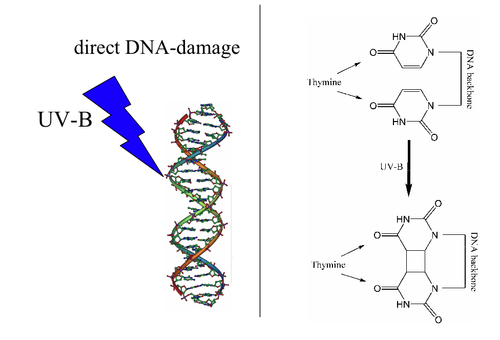Direct DNA damage

Direct DNA damage can occur when DNA directly absorbs a UVB photon, or for numerous other reasons. UVB light causes thymine base pairs next to each other in genetic sequences to bond together into pyrimidine dimers, a disruption in the strand, which reproductive enzymes cannot copy. It causes sunburn and it triggers the production of melanin.[1]
Other names for the "direct DNA damage" are:[2]
- thymine dimers
- pyrimidine dimers
- Cyclobutane Pyrimidine Dimers (CPDs)
- UV-endonuclease-sensitive-sites (ESS)
Due to the excellent photochemical properties of DNA, this nature-made molecule is damaged by only a tiny fraction of the absorbed photons. DNA transforms more than 99.9% of the photons into harmless heat[3] (but the damage from the remaining < 0.1% is still enough to cause sunburn).[1] The transformation of excitation energy into harmless heat occurs via a photochemical process called internal conversion. In DNA, this internal conversion is extremely fast, and therefore efficient. This ultrafast (subpicosecond) internal conversion is a powerful photoprotection provided by single nucleotides.[3] However, the Ground-State Recovery is much slower (picoseconds) in G·C−DNA duplexes and hairpins.[4] It is presumed to be even slower for double-stranded DNA in conditions of the nucleus. The absorption spectrum of DNA shows a strong absorption for UVB radiation and a much lower absorption for UVA radiation. Since the action spectrum of sunburn is indistinguishable from the absorption spectrum of DNA, it is generally accepted that the direct DNA damages are the cause of sunburn.[1] While the human body reacts to direct DNA damages with a painful warning signal,[1] no such warning signal is generated from indirect DNA damage.
Sunscreen and melanoma
A study by Hanson suggests sunscreen that penetrates into the skin and thereby amplifies the amount of free radicals and oxidative stress [5] contributes to the formation of melanoma, but this idea has not been validated by other researchers.
Effect of topical sunscreen and effect of absorbed sunscreen
Direct DNA damage is reduced by sunscreen. This prevents sunburn. When the sunscreen is at the surface of the skin, it filters the UV rays, which attenuates the intensity. Even when the sunscreen molecules have penetrated into the skin, they protect against direct DNA damage, because the UV light is absorbed by the sunscreen and not by the DNA.[6]
See also
References
- 1 2 3 4 John A. Parrish; Kurt F. Jaenicke; R. Rox Anderson (1982). "Erythema and melanogenesis action spectra of normal human skin". Photochemistry and Photobiology. 36 (2): 187–191. doi:10.1111/j.1751-1097.1982.tb04362.x. PMID 7122713.
- ↑ Effects of Solar Ultraviolet Photons on Mammalian Cell DNA
- 1 2 "Ultrafast Photodynamics of Nucleic Acids". Retrieved 2008-02-13.
- ↑ Ground-State Recovery Following UV Excitation is Much Slower in G·C−DNA Duplexes and Hairpins Than in Mononucleotides: Carlos E. Crespo-Hernndez†, Kimberly de La Harpe and Bern Kohler. http://pubs.acs.org/doi/abs/10.1021/ja802183s
- ↑ Hanson Kerry M.; Gratton Enrico; Bardeen Christopher J. (2006). "Sunscreen enhancement of UV-induced reactive oxygen species in the skin". Free Radical Biology and Medicine. 41 (8): 1205–1212. doi:10.1016/j.freeradbiomed.2006.06.011. PMID 17015167.
- ↑ Gulston M, Knowland J (July 1999). "Illumination of human keratinocytes in the presence of the sunscreen ingredient Padimate-O and through an SPF-15 sunscreen reduces direct photodamage to DNA but increases strand breaks". Mutat Res. 444 (1): 49–60. doi:10.1016/s1383-5718(99)00091-1. PMID 10477339.